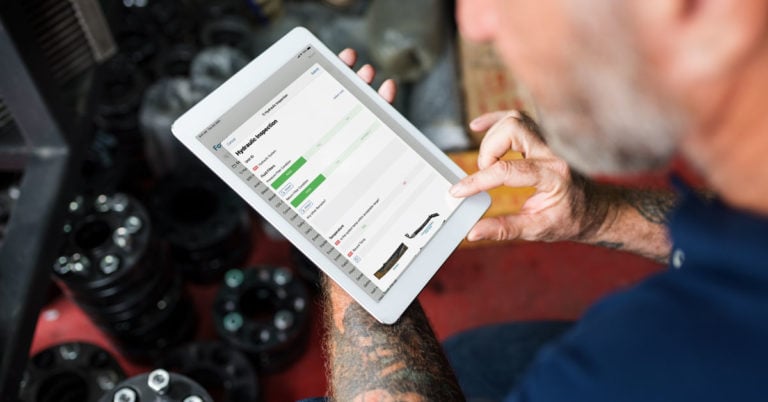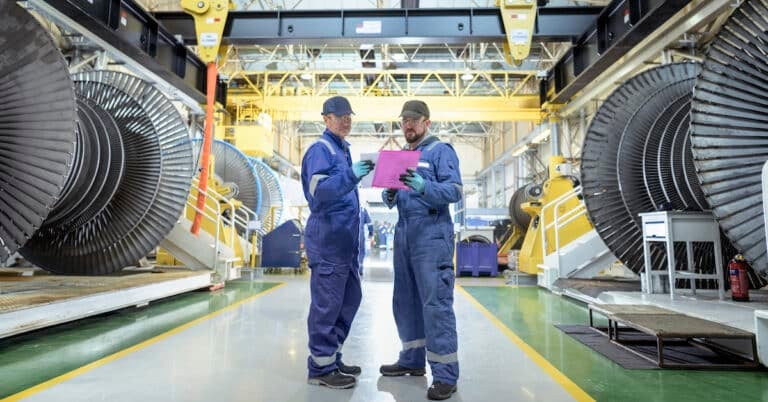Do you want to know the secret to avoiding OSHA fines? Put the systems and support in place to prevent violations in the first place. With the support of software, digitization, and automation, your employees have all the tools they need to carry out the proper safety protocols right at their fingertips. Redlist has a long list of features that can be configured to fit your specific needs, but today we’ll cover how it can help you prevent the top 10 OSHA violations.
1. Exit Routes and Maintenance Safeguards
Keeping all exit routes clear by ensuring no materials or equipment are left in the way, even temporarily, is best covered in your safety training and supported through proper signage. However, this OSHA violation includes having your emergency safeguards like sprinkler systems, alarms, and fire doors functional and able to perform at all times. These systems are rarely used, which is a good thing, but that means they aren’t top of mind for preventive maintenance. Setting a recurring inspection, as well as a timeline for probable replacement based on the average lifespan of the system, will enable your safety team to keep these systems in proper working order at all times.
2. Lockout/Tagout Energy Control
Protecting employees from unexpected energization of equipment while servicing isn’t as simple as just having an energy control plan for every piece of equipment or machinery that ever needs maintenance. In an asset-heavy industry, that’s a lot for anyone to remember. With Redlist, you have the peace of mind that your entire inventory of assets that need a lockout/tagout energy control plan is covered. You can digitize step-by-step guides to walk employees through the lockout/tagout procedures and capture their digital sign-off to ensure that the equipment is properly de-energized every time maintenance is performed. Additionally, OSHA requires employers to inspect these procedures at least once per year, which can be set up and tracked through Redlist to easily record your inspection reports in case of an OSHA inspection.
3 and 4. Guarding Requirements
Guarding requirements are covered by a couple of different OSHA regulations based on what the guarding is for. The first part being protection from hazards caused by points of operation, ingoing nip points, flying chips and sparks, and rotating parts. Part two involves guarding all kinds of power transmission belts, flywheels, belts, ropes, train drives, chains and sprockets, pulleys, horizontal belts and ropes, overhead horizontal belts, and vertical and inclined belts. Providing the appropriate safeguards may seem like a one-and-done step, but do you have a checklist or system in place to make sure this is done for every new asset? Redlist can assist in making sure this is done for new assets and also when preventive maintenance is performed. These guards are often removed for maintenance and accidentally left off, leaving your employees exposed to these hazards and you exposed to an OSHA violation. This is handled by simply adding steps to the preventive maintenance program to remind and ensure that the guards are replaced.
5. Electrical Equipment and Training
When it comes to electricity and electrical equipment, the list of possible OSHA violations is quite long. You have to ensure that the equipment is installed properly, remains free from recognized hazards, is used according to manufacturer instructions, all unused openings are closed, all disconnecting means and circuits are clearly labeled, sufficient space is provided for operation and maintenance, very specific training requirements are met, and the list goes on. It would be impossible for you or a supervisor to always be on hand to make sure all safety precautions are met when this equipment is used. Instead, you can provide all of your expert guidance once when setting up your software and be there for every employee at any time.
6. Personal Protective Equipment
Personal protective equipment (PPE) suited to the body part needing protection and work being performed must be provided and inspected/tested regularly. Do you know when your PPE needs to be inspected again or even when the last inspection took place? Keeping personal protective equipment on hand is one thing, but checking it to make sure it is in reliable condition to perform and tracking those inspections requires a bit more work. Even if you do inspect and test your PPE on a regular basis, do you keep records of it? How easy would it be to gather your paper inspection records in the event of an OSHA inspection? Streamlining all of this in your Redlist software goes a long way in preventing a violation.
7. Recordkeeping and Reporting
Quite possibly the biggest contribution to preventing an OSHA violation is good recordkeeping! Knowing when things were reported, when inspections were completed, any maintenance that was done, and being able to quickly gather that information and report it to OSHA when needed is a lifesaver. There are very specific timelines to follow when reporting an incident to OSHA, so it is important to know what and when to file a report and also provide all the supporting documentation.
8. Walking-Working Surfaces
All walking-working surfaces have to be inspected and maintained regularly as necessary, and the day-to-day condition must be clean, orderly, sanitary, and as dry as possible. When you’re focused on production or maintenance of highly-used assets, the inspection, maintenance, and daily condition of the ground in your workspace falls much lower on the list. Digitization of maintenance workflows ensures these “lower priority” tasks are completed.
9. Ladders
If you’re an employer, the responsibility falls on you to make sure that ladders are inspected before the first use of every work shift. In a world where productivity impacts the bottom line, it is human nature to sometimes rush or forget to do a safety inspection. A simple system to remind employees of these steps and record their inspection makes it easier for them to complete the inspection and get back to the job at hand.
10. Powered Industrial Trucks
The list of potential OSHA violations for powered industrial trucks is as long, if not longer, than the list for electrical equipment and training. There are requirements for training, retraining, and regular evaluations of operators, as well as requirements for inspection, maintenance, battery charging, loading/unloading, and modifications to the powered industrial truck. Providing the systems and support for your employees to safely follow all regulations for training, maintenance, and daily operations is one of the only ways to know that everything is being completed precisely to OSHA requirements.
Part of preventing these top 10 OSHA violations is through the steps outlined above, but the other part is simply being prepared if or when an OSHA inspection happens. Redlist streamlines both sides of this preventive action through ensuring safety checks, inspection, and maintenance are completed, then having efficient recordkeeping and reporting available at a moment’s notice.


